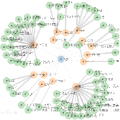A Temporal Knowledge Graph (TKG) is a sequence of KGs with respective timestamps, which adopts quadruples in the form of (\emph{subject}, \emph{relation}, \emph{object}, \emph{timestamp}) to describe dynamic facts. TKG reasoning has facilitated many real-world applications via answering such queries as (\emph{query entity}, \emph{query relation}, \emph{?}, \emph{future timestamp}) about future. This is actually a matching task between a query and candidate entities based on their historical structures, which reflect behavioral trends of the entities at different timestamps. In addition, recent KGs provide background knowledge of all the entities, which is also helpful for the matching. Thus, in this paper, we propose the \textbf{Hi}storical \textbf{S}tructure \textbf{Match}ing (\textbf{HiSMatch}) model. It applies two structure encoders to capture the semantic information contained in the historical structures of the query and candidate entities. Besides, it adopts another encoder to integrate the background knowledge into the model. TKG reasoning experiments on six benchmark datasets demonstrate the significant improvement of the proposed HiSMatch model, with up to 5.6\% performance improvement in MRR, compared to the state-of-the-art baselines.
翻译:时间知识图( TKG) 是 KGs 的序列, 包含相应的时间戳, 以描述动态事实 。 TKG 的推理为许多真实世界应用提供了便利, 解答诸如 (emph{ query 实体},\emph{queri relation},\emph{ {?}?},\emph{ futy timetamp}) 等关于未来的问询和候选实体之间的一个匹配任务, 其形式为 (\ emph{ subject},\ emph{ relation},\ emph{ relation}, 以它们的历史结构为基础, 反映各实体在不同时间戳中的行为趋势, \ emph{ { object} 。 此外, 最近 KGs 提供了所有实体的背景知识, 这也有助于匹配 。 因此, 在本文中, 我们建议将 \ textf{ textf} 模式\ textfff} 和 textf{ matchtroup} groadmroduction) 的改进 。 它在历史模型中将两个数据结构整合成历史数据库。




